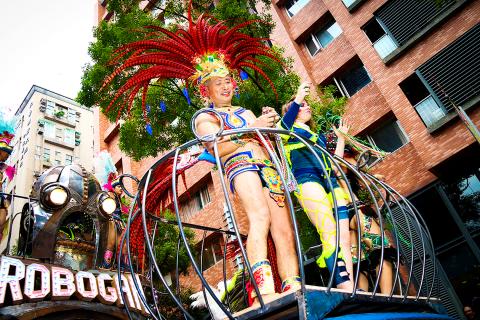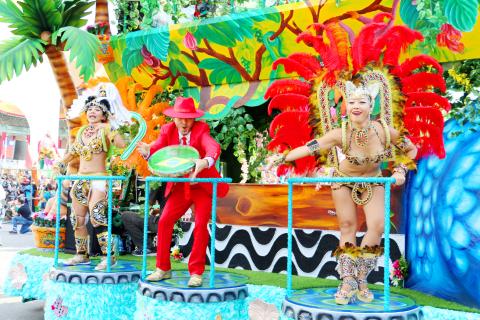The expanse between the Chiang Kai-shek Memorial and Ketagalan Boulevard (凱達格蘭大道) in downtown Taipei on Saturday will be filled with feathered headpieces and the beat of samba drums as the Dream Community’s (夢想社區) 15th annual Dream Parade takes to the streets for three hours of Brazilian-inspired carnival madness.
While previous parades have almost always had some kind of a theme to unify the various floats and community creations, this year the organizers have tried something different: to tell an original story, a “heavy-metal fairytale.”
The story they came up with is about a rich, selfish man who has a very big nose that he uses to sniff out money, but no ears or eyes and a huge home, complete with its own amusement park, including a toboggan run. Afraid that nearby villagers want to break into his home to access the park, he has a huge robot built to protect it. However, the welders create a robot with a heart, able to see and understand the injustices that surround it. The robot decides to let himself rust, so the amusement park will become too dangerous to use.

Photo Courtesy of Earica Brown
So the rich man decides to dispose of the robot and places it on a truck to take to the dump. The robot escapes, taking the toboggan, lights and other parts of the park with him, and drives the truck to a nearby village, where it lets the villagers play with all the attractions.
Now, organizers say, it is the turn of Taipei residents to play and party with the robot.
Five metal sculptors who have worked on the famed Nice carnival in France were invited to participate in this year’s parade, and they built the robot float, which is named “Robo Gan.”

Photo Courtesy of Earica Brown
Gordon Tsai (蔡聰明), the founder of the Dream Community in New Taipei City’s Shijr District (汐止), said there will be about 100 teams participating in the parade from around Taiwan as well as Malaysia, Indonesia and China, where Tsai has been helping launch similar community festivals for the past two years.
The Dream Community, which was founded on the idea of community-based celebratory art, requires the people who buy apartments in the community to agree to organize a team to take part in the annual parade and other activities.
However, the parade also attracts groups from area high schools and universities, as well as the samba drumming groups Tsai has helped found at elementary and junior high schools in Aboriginal communities around the nation.

Photo Courtesy of Che A-kuei
The school drumming teams will be vying against one another in the National Dream Cup Samba Drum competition for musical instruments and other prizes for their schools.
The parade begins at 3pm at the Liberty Plaza at the National Chiang Kai-shek Memorial between the National Theater and Concert Hall.
The 1.2km-long route takes the participants up Zhongshan South Road (中山南路) to Renai Road (仁愛路), where they make a right turn and head toward Linsen South Road (林森南路) and a U-turn that sends them back toward Ketagalan Boulevard.
Unlike the past few years, there will be no after-parade party on Ketagalan, apparently because doctors told Tsai, who has suffered some health problems this year, to take life a bit easier.
However, Tsai, whose fire-breathing antics are one of the hallmarks of the parade, says he is feeling fine and will be his usual exuberant self on Saturday.
Tsai and his crew staged a test run of the parade floats in their Shijr neighborhood on Saturday last week, despite the drizzle, and he assured me that despite the wetness that has plagued Taipei this week, the samba ladies, drummers, floats and others will be out in force on Saturday afternoon, come rain or shine.

June 2 to June 8 Taiwan’s woodcutters believe that if they see even one speck of red in their cooked rice, no matter how small, an accident is going to happen. Peng Chin-tian (彭錦田) swears that this has proven to be true at every stop during his decades-long career in the logging industry. Along with mining, timber harvesting was once considered the most dangerous profession in Taiwan. Not only were mishaps common during all stages of processing, it was difficult to transport the injured to get medical treatment. Many died during the arduous journey. Peng recounts some of his accidents in

“Why does Taiwan identity decline?”a group of researchers lead by University of Nevada political scientist Austin Wang (王宏恩) asked in a recent paper. After all, it is not difficult to explain the rise in Taiwanese identity after the early 1990s. But no model predicted its decline during the 2016-2018 period, they say. After testing various alternative explanations, Wang et al argue that the fall-off in Taiwanese identity during that period is related to voter hedging based on the performance of the Democratic Progressive Party (DPP). Since the DPP is perceived as the guardian of Taiwan identity, when it performs well,

A short walk beneath the dense Amazon canopy, the forest abruptly opens up. Fallen logs are rotting, the trees grow sparser and the temperature rises in places sunlight hits the ground. This is what 24 years of severe drought looks like in the world’s largest rainforest. But this patch of degraded forest, about the size of a soccer field, is a scientific experiment. Launched in 2000 by Brazilian and British scientists, Esecaflor — short for “Forest Drought Study Project” in Portuguese — set out to simulate a future in which the changing climate could deplete the Amazon of rainfall. It is

The Taiwan People’s Party (TPP) on May 18 held a rally in Taichung to mark the anniversary of President William Lai’s (賴清德) inauguration on May 20. The title of the rally could be loosely translated to “May 18 recall fraudulent goods” (518退貨ㄌㄨㄚˋ!). Unlike in English, where the terms are the same, “recall” (退貨) in this context refers to product recalls due to damaged, defective or fraudulent merchandise, not the political recalls (罷免) currently dominating the headlines. I attended the rally to determine if the impression was correct that the TPP under party Chairman Huang Kuo-Chang (黃國昌) had little of a